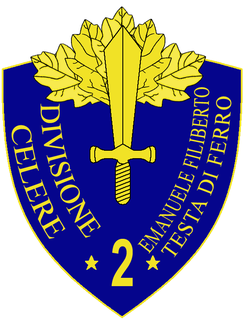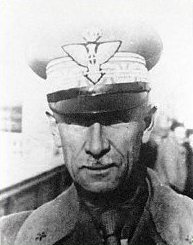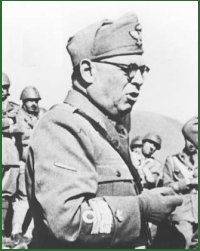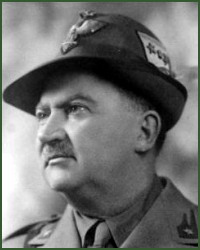Related Research Articles

The 3rd Cavalry Division "Principe Amedeo Duca d'Aosta" was a Cavalry or "Celere" (Fast) division of the Royal Italian Army during World War II. The division was formed in 1934, and during World War II was mobilized in June 1940. As a cavalry division it took part in the Invasion of Yugoslavia and was part of the Italian Expeditionary Corps in Russia. Annihilated during the Red Army's Operation Little Saturn in December 1942, the survivors returned to Italy in spring 1943.

The 1st Cavalry Division "Eugenio di Savoia" was a cavalry or "Celere" (Fast) division of the Royal Italian Army during World War II. The Eugenio di Savoia was mobilized in 1940 and took part in the Invasion of Yugoslavia. The division was assigned to the XI Corps in Ljubljana and remained in Yugoslavia as occupation force on the Dalmatian coast. After the Armistice of Cassibile on 8 September 1943 the division was disbanded by the Germans.

The 2nd Cavalry Division "Emanuele Filiberto Testa di Ferro" was a Cavalry or "Celere" (Fast) division of the Royal Italian Army during World War II. The division was mobilised in 1940, it did not take part in the Italian invasion of France, but did serve in the Invasion of Yugoslavia and remained in Yugoslavia as part of the occupying forces. In March 1942 the division's 6th Bersaglieri Regiment was sent to the Soviet Union attached to the 3rd Cavalry Division "Principe Amedeo Duca d'Aosta". In May 1942 the division started converting to an armored division, however, the conversion was cancelled and it returned to the Cavalry format. In December 1942, the division moved to France as part of the Italian occupying forces where it was based in Toulon. The division remained in France until the Armistice of Cassibile was announced on 8 September 1943 and was then disbanded by the invading Germans.

The Axis order of battle for the invasion of Yugoslavia was made up of the various operational formations of the German Wehrmacht and Waffen-SS, Italian Armed Forces and Hungarian Armed Forces that participated in the invasion of Yugoslavia during World War II, commencing on 6 April 1941. It involved the German 2nd Army, with elements of the 12th Army and a panzer group combined with overwhelming Luftwaffe support. The eighteen German divisions included five panzer divisions, two motorised infantry divisions and two mountain divisions. The German force also included two well-equipped independent motorised regiments and was supported by over 800 aircraft. The Italian 2nd Army and 9th Army committed a total of 22 divisions, and the Royal Italian Air Force had over 650 aircraft available to support the invasion. The Hungarian 3rd Army also participated, with support from the Royal Hungarian Air Force.
The 538th Frontier Guard Division, also known as the Division z.b.V. 538. was a short-lived German division in World War II that participated in the invasion of Yugoslavia. It was disbanded immediately after the Yugoslav surrender.
The VI Corps was a corps of the Royal Italian Army during World War II that participated in the invasion of Yugoslavia.
The XI Army Corps was a corps of the Royal Italian Army during World War II that participated in the invasion of Yugoslavia.
The Motorized Corps was a corps of the Royal Italian Army during World War II that participated in the invasion of Yugoslavia.
The XIV Corps was a corps of the Royal Italian Army during World War II that participated in the invasion of Yugoslavia.
The XVII Army Corps was an army corps of the Royal Italian Army during World War II that participated in the invasion of Yugoslavia. It was formed on 1 March 1940 from the Armored Corps of the reserve Army of the Po and sent to the Albanian front.
The Librazhd Sector was a corps-sized defensive sector of the Royal Italian Army in Albania during World War II that defended against an offensive during the invasion of Yugoslavia.

Federico Ferrari Orsi was a general in the Royal Italian Army during World War II.
Riccardo Balocco was a general in the Royal Italian Army who commanded the V Corps during the World War II Axis invasion of Yugoslavia in April 1941.
Mario Robotti (1882–1955) was a general in the Royal Italian Army who commanded the XI Corps during the World War II Axis invasion of Yugoslavia in April 1941. He then became military commander in the province of Ljubljana, the Italian zone of occupied Slovenia.

Francesco Zingales (1884-1959) was a general in the Royal Italian Army during World War II.
Giovanni Vecchi was a general in the Royal Italian Army who commanded the XIV Corps during the World War II Axis invasion of Yugoslavia in April 1941.
Giuseppe Pafundi was a general in the Royal Italian Army who commanded the XVII Corps during the World War II Axis invasion of Yugoslavia in April 1941.

Gabriele Nasci was a general in the Royal Italian Army who commanded the Librazhd Sector during the World War II Axis invasion of Yugoslavia in April 1941. He commanded the Alpine Army Corps from 1942 until 1943, and allied himself with the Yugoslavian partisans following the Italian armistice.
The 3rd Alpine Group was a formation of the Royal Italian Army manned by Alpini troops that participated in the Axis invasion of Yugoslavia during World War II.
The 6th Army was a World War I and World War II field army of the Royal Italian Army.
References
- Nafziger, George (1997). "Italian 2nd & 9th Army – Invasion of Yugoslavia – 5 April 1941" (PDF). Combined Arms Research Library Digital Library. Archived from the original (PDF) on 22 March 2014. Retrieved 20 July 2013.